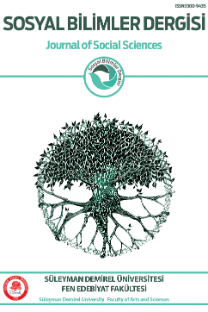Evaluation of Industrialization Effects on Urbanization and Heat Island Formation Using Remote Sensing Technologies: A Case of Istanbul Bağcılar District
___
- ARSLAN, M. (1987). Taburabat definesi Arcadius devri sikkeleri, Anadolu Medeniyetleri Müzesi Yıllığı, 1986, 45-50.
- ARSLAN, M. (1989). Taburabat definesi Roma devri sikkeleri, Anadolu Medeniyetleri Müzesi Yıllığı, 1988, 156-167. (İngilizce özet)
- ARSLAN, M. (1999). The Taburabat Hoard, C. S. Lightfoot (Ed.), Recent Turkish Coin Hoards and Numismatic Studies içinde (s. 43-55), Oxford.
- CARSON, R. A. G. (1990). Coins of the Roman Empire, London&New York.
- CARSON, R. A. G., HİLL P. V., KENT, J. P. C. (1989). Late Roman Bronze Coinage (LRBC II), London.
- KENT, J. P. C. (1981). The Roman Imperial Coinage VIII. The Family of Constantine I. A. D. 337-364 (RIC VIII), London.
- PEARCE, J. W. E. (1951). The Roman Imperial Coinage IX. Valentinian I – Theodosius I, (RIC IX), London.
- KENT, J. P. C. (1994). The Roman Imperial Coinage X. The Divided Empire and the Fall of the Western Parts AD. 394-491 (RIC X), London.
- SEEGER, A. (1976). A Hoard of Late Roman Bronze Coins, Coin Hoards, 2, 55-60.
- THOMSEN, R. (1986). The Greco-Romen Coins. A. P. Christensen, R. Thomsen, G. Ploug (Ed.), Hama: foulles et recherches 1931-1938 III. 3: The Greco-Roman objects of clay, the coins and the necropolis içinde (s. 59-69), Copenhagen.
- ISSN: 1300-9435
- Yayın Aralığı: 3
- Başlangıç: 1995
- Yayıncı: Süleyman Demirel Üniversitesi, Fen-Edebiyat Fakültesi
TRABZON DERNEKPAZARI YENİCE KÖYÜ’NDE TARİHİ AHŞAP BİR KÖPRÜ
998 ve 1112 Numaralı Tapu Tahrir Defterlerine Göre Siirt Vakıfları (1526-1566)
Gülcan SARP, Kadir TEMURÇİN, Yolcu ALDIRMAZ
Taşkın Risk Haritalarında AHP Yönteminin Uygulanması: Aksu Çayı Havzası Örneği
Türkülerde Erzurum: Bir Şehir Kimliği Çalışması
III. MURAD’A SUNULAN CİHAD-NÂME’NİN MÜELLİFİ ÜZERİNE BİR İNCELEME
Kadir KASALAK, Şengül BÜYÜKBOYACI
